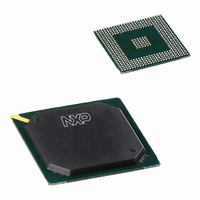PNX1502E,557 NXP Semiconductors, PNX1502E,557 Datasheet - Page 273

PNX1502E,557
Manufacturer Part Number
PNX1502E,557
Description
IC MEDIA PROC 300MHZ 456-BGA
Manufacturer
NXP Semiconductors
Specifications of PNX1502E,557
Applications
Multimedia
Core Processor
TriMedia
Controller Series
Nexperia
Interface
I²C, 2-Wire Serial
Number Of I /o
61
Voltage - Supply
1.23 V ~ 1.37 V
Operating Temperature
0°C ~ 85°C
Mounting Type
Surface Mount
Package / Case
456-BGA
Lead Free Status / RoHS Status
Lead free / RoHS Compliant
Program Memory Type
-
Ram Size
-
Lead Free Status / Rohs Status
Not Compliant
Other names
935274744557
PNX1502E
PNX1502E
PNX1502E
PNX1502E
Available stocks
Company
Part Number
Manufacturer
Quantity
Price
Company:
Part Number:
PNX1502E,557
Manufacturer:
NXP Semiconductors
Quantity:
10 000
- Current page: 273 of 828
- Download datasheet (8Mb)
Philips Semiconductors
Volume 1 of 1
PNX15XX_SER_3
Product data sheet
2.1.3 GPIO Pin Status Reading
2.2 GPIO: The Event Monitoring Mode
Each GPIO pin can be read by software using an MMIO read of the proper MASK and
IOD register. In the 32-bit register, the lower 16 bits are the GPIO pin data values.
Software reading of the GPIO input pins is always possible, even when the GPIO pin
is operating in its primary function mode.
Remark: For open drain or tri-state output values, the input value read by software is
the pad value, not the driven value.
The GPIO module allows to monitor events on all 61 GPIO pins but also on some
PNX15xx Series internal signals coming from the different modules of PNX15xx
Series. These signals are usually signals indicating the end or the start of the capture
of a buffer. Documentation on the following signals can be found on each module
documentation.
The state of these internal signals can be observed by software at any time by
consulting the Internal Signals MMIO register documented in
PNX15xx Series integrates a total of 12 timestamp units for event monitoring. An
event is defined by a change on the monitored signals, i.e. a high to low or a low to
high transition is an event. The operating mode of the timestamp units is simple:
•
•
•
•
•
•
•
•
•
VIP timestamp: vip1_eow_vbi, vip_eow_vid
AI timestamp: ai1_tstamp
AO timestamp: ao1_tstamp
SDPI: spdi_tstamp1, spdi_tstamp2 (See SPDI MUX in
SPDO: spdo_tstamp
GPIO timestamps: LAST_WORD[3:0]
QVCP timestamp: qvcp_tstamp
The software running on TM3260 selects the internal signals or the GPIO pins to
be event monitored by setting properly the GPIO_EV[15:4] MMIO registers.
These 12 control registers (one per timestamp unit) are used to select the source
to monitor, the type of the event (rising, falling edge or both) as well as enabling
the capture of the event.
Every time an event occurs a DATA_VALID interrupt is generated. Therefore the
DATA_VALID interrupt condition needs to be enabled by writing to the
INT_ENABLE4 MMIO register (the GPIO generates the interrupt through
interrupt line 4 which is connected to the TM3260, see
SOURCE number allocation). The INT_STATUS4 MMIO register indicates which
of the 12 units has data ready to consume. The GPIO module expects then an
interrupt clear by writing to the INT_CLEAR4 MMIO register.
Rev. 3 — 17 March 2006
Chapter 8: General Purpose Input Output Pins
© Koninklijke Philips Electronics N.V. 2006. All rights reserved.
PNX15xx Series
Section 8.1 on page
Table 5 on page 3-12
Section
4.3.
3-27)
for
8-6
Related parts for PNX1502E,557
Image
Part Number
Description
Manufacturer
Datasheet
Request
R
Part Number:
Description:
Digital Signal Processors & Controllers (DSP, DSC) MEDIA PROCESSOR PNX15XX/300MHZ
Manufacturer:
NXP Semiconductors

Part Number:
Description:
IC MEDIA PROC 300MHZ 456-BGA
Manufacturer:
NXP Semiconductors
Datasheet:
Part Number:
Description:
NXP Semiconductors designed the LPC2420/2460 microcontroller around a 16-bit/32-bitARM7TDMI-S CPU core with real-time debug interfaces that include both JTAG andembedded trace
Manufacturer:
NXP Semiconductors
Datasheet:

Part Number:
Description:
NXP Semiconductors designed the LPC2458 microcontroller around a 16-bit/32-bitARM7TDMI-S CPU core with real-time debug interfaces that include both JTAG andembedded trace
Manufacturer:
NXP Semiconductors
Datasheet:
Part Number:
Description:
NXP Semiconductors designed the LPC2468 microcontroller around a 16-bit/32-bitARM7TDMI-S CPU core with real-time debug interfaces that include both JTAG andembedded trace
Manufacturer:
NXP Semiconductors
Datasheet:
Part Number:
Description:
NXP Semiconductors designed the LPC2470 microcontroller, powered by theARM7TDMI-S core, to be a highly integrated microcontroller for a wide range ofapplications that require advanced communications and high quality graphic displays
Manufacturer:
NXP Semiconductors
Datasheet:
Part Number:
Description:
NXP Semiconductors designed the LPC2478 microcontroller, powered by theARM7TDMI-S core, to be a highly integrated microcontroller for a wide range ofapplications that require advanced communications and high quality graphic displays
Manufacturer:
NXP Semiconductors
Datasheet:
Part Number:
Description:
The Philips Semiconductors XA (eXtended Architecture) family of 16-bit single-chip microcontrollers is powerful enough to easily handle the requirements of high performance embedded applications, yet inexpensive enough to compete in the market for hi
Manufacturer:
NXP Semiconductors
Datasheet:

Part Number:
Description:
The Philips Semiconductors XA (eXtended Architecture) family of 16-bit single-chip microcontrollers is powerful enough to easily handle the requirements of high performance embedded applications, yet inexpensive enough to compete in the market for hi
Manufacturer:
NXP Semiconductors
Datasheet:
Part Number:
Description:
The XA-S3 device is a member of Philips Semiconductors? XA(eXtended Architecture) family of high performance 16-bitsingle-chip microcontrollers
Manufacturer:
NXP Semiconductors
Datasheet:

Part Number:
Description:
The NXP BlueStreak LH75401/LH75411 family consists of two low-cost 16/32-bit System-on-Chip (SoC) devices
Manufacturer:
NXP Semiconductors
Datasheet:

Part Number:
Description:
The NXP LPC3130/3131 combine an 180 MHz ARM926EJ-S CPU core, high-speed USB2
Manufacturer:
NXP Semiconductors
Datasheet:

Part Number:
Description:
The NXP LPC3141 combine a 270 MHz ARM926EJ-S CPU core, High-speed USB 2
Manufacturer:
NXP Semiconductors

Part Number:
Description:
The NXP LPC3143 combine a 270 MHz ARM926EJ-S CPU core, High-speed USB 2
Manufacturer:
NXP Semiconductors

Part Number:
Description:
The NXP LPC3152 combines an 180 MHz ARM926EJ-S CPU core, High-speed USB 2
Manufacturer:
NXP Semiconductors











